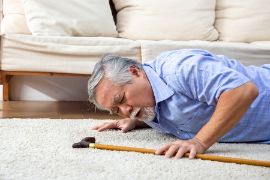Falls are among the leading causes of serious injury (e.g., fractures) and death for seniors in the United States. There are a number of factors that play a role in an individual's ability to maintain good balance, such as ear and visual health, core muscle strength, and nervous system function, among other factors.
 Balance problems may develop due to an injury or illness that negatively affects one of these regions. For older individuals, balance problems are often linked to vertigo, ear infections, hearing loss, heart problems, posture changes, arthritis, certain medications, loss of strength, and conditions that affect the nervous system (e.g., Alzheimer's disease, Multiple sclerosis, Parkinson's disease). When older individuals fall, they may experience, soft tissue damage, fractures, persistent pain, loss of self-confidence, a reduced quality of life due to functional impairments, heightened health-care costs, and an increased risk of death. Falls are among the leading causes of serious injury (e.g., fractures) and death for seniors in the United States.
Balance problems may develop due to an injury or illness that negatively affects one of these regions. For older individuals, balance problems are often linked to vertigo, ear infections, hearing loss, heart problems, posture changes, arthritis, certain medications, loss of strength, and conditions that affect the nervous system (e.g., Alzheimer's disease, Multiple sclerosis, Parkinson's disease). When older individuals fall, they may experience, soft tissue damage, fractures, persistent pain, loss of self-confidence, a reduced quality of life due to functional impairments, heightened health-care costs, and an increased risk of death. Falls are among the leading causes of serious injury (e.g., fractures) and death for seniors in the United States.
As falls are particularly common among seniors, they are often described as a high-risk population that requires individually tailored approaches to fall prevention. Beneficial approaches include risk factor assessment, multicomponent exercise, physical therapy, dietary supplementation, and safety improvements for the home or other settings where seniors frequently gather. Exercise and strength are of the most important of these preventive measures.
Research shows that there are a number of useful exercises for older individuals that help prevent falls by improving muscle strength and balance.
These include:
- Walking heel to toe
- Standing on one foot
- Standing on one foot with arm movements
- Standing on one foot and tracing half the clock face with the free foot
- Side leg raise
- Back leg raise
- Core strengthening i.e. squats
Walking heel to toe is an exercise that makes the legs stronger and in doing so, helps older individuals walk without falling. In order to perform this exercise, place the right foot in front of the left foot so that the right foot's heel is touching the tips of the toes on the left foot. Next, move the left foot in front of the right one, place the weight on the heel, and then shift the weight to the toes. Repeat this motion with the right foot and then walk heel to toe for at least 20 steps. It’s great to practice this in a hallway where there are nearby walls for support if needed.
When practicing exercises standing on one leg (single limb stance), the individual should stand behind a steady chair that does not have wheels and hold on to the back of it with the least amount of grip needed to resist falling. Next, lift the right foot while balancing on the left and hold this position for as long as possible before switching to the other foot. The long-term goal is to be able to balance on one foot for up to one minute without having to hold on to the chair. These types of exercises promote optimal balance by increasing the strength of core muscles as well as those in the limbs. Please note that although this exercise is easy to do, guidance may be necessary especially if the exercise is performed during a recovery period.
If you would like to learn how to prevent falls, consider working with a physical therapist who can demonstrate techniques such as balance and strength training, as well as stretching exercises that can build strong muscles, restore good posture, encourage proper bodily movement, and help prevent falls. In addition, if you were seriously injured due to a fall, the physical therapists at Dynamics Physical Therapy can develop an individualized plan, which may include home modifications or assistive devices (e.g., cane, walker) that will help restore your mobility, provide pain management, and improve overall health. Call today to speak with one of our compassionate and caring physical therapists.
References
1. Røyset B,et al. Effects of a fall prevention program in elderly: a pragmatic observational study in two orthopedic departments. Clin Interv Aging. 2019;14:145-154.
2. Johnston M, Magnan MA. Using a Fall Prevention Checklist to Reduce Hospital Falls: Results of a Quality Improvement Project. Am J Nurs. 2019;119(3):43-49.
3. Karinkanta S, Piirtola M, et al. Physical therapy approaches to reduce fall and fracture risk among older adults. Nat Rev Endocrinol. 2010;6(7):396-407.
4. Petridou T, Manti G, et al. What works better for community‑dwelling older people at risk to fall?: a meta‑analysis of multifactorial versus physical exercise‑alone interventions. J. Aging Health. 2009;21(5):713-729.
5. Frieson CW, et al. Editorial: Evidence-Based Practices to Reduce Falls and Fall-Related Injuries Among Older Adults. Front Public Health. 2018;6:222.


